Apple on Tuesday announced its most profitable quarter in company history, and held a financial conference call with analysts and members of the media. Several notes of interest from the finished call follow:
Apple regional business segments
Apple Americas accounted for 841,000 Mac sales and $4.298B in revenues. These figures are up 35 percent and 22 percent year-over-year. Sequentially, however, shipments are down 17 percent with revenue up 9 percent.
Apple Europe accounted for 705,000 Mac sales and $2.471B in revenues. Both these figures are up 44 percent and 36 percent year-over-year, and up 41 percent and 85 percent sequentially.
Apple Japan accounted for 91,000 Mac sales and $400M in revenues. These figures have increased by 30 and 40 percent year-over-year, as well as 26 and 57 percent sequentially.
Japan's surprise bounce-back in sales was led by strong receptions to the iMac and the iPod touch.
Apple's Asia Pacific (and FileMaker Inc) accounted for 178,000 Mac sales and $738M in revenues. These figures are up 59 percent and 53 percent year-over-year. Sequentially, unit sales rose 15 percent in the Asia Pacific regions with revenue increasing 66 percent.
Apple's "Other Music Related Products and Services" segment accounted for $808M in revenue. The figure represents a 27 percent year-over-year increase and a 34 percent sequential lift to Apple's results.
Apple's "Peripherals and Other Hardware" added $382M in revenue, representing a 29 percent growth year-over-year and 10 percent sequentially.
Apple's "Software, Service and Other Sales" segment accounted for $628M in revenue, a spike of 81 percent year-over-year and 46 percent sequentially.
There was an "incredible growth" in the audio and video businesses, driven by Logic 8 and Final Cut Studio 2. The digital media production space was nonetheless "slow," Apple noted.
Apple's Mac business
Apple sold 977,000 desktops during the quarter and 1,342,000 notebooks. The figures signal Mac shipment increases of 53 and 38 percent for each category year-over-year, but virtually flat sequential sales for notebooks and a 20 percent sequential increase for desktops.
Macs accounted for 47 percent of total revenue and exceeded forecasts by 700,000 units. At an increase of 44 percent year-over-year, this growth was more than 2.5 times the market growth rate, according to IDC numbers.
Leopard revenue was $170 million in the quarter, up from $100 million for Tiger in its own first quarter; about 19 percent of the Mac user base is already believed to be using the new software.
Sales of the new iMac continue to be very "robust." The iMac had "enormous momentum" and grew at over five times IDC's projected average for desktop sales.
The educational market saw a record quarter and grew about five times IDC's projected growth, both in K-12 and higher education. Larger businesses are also interested in the Mac.
The MacBook Air is seeing "very strong" pre-orders, but it's too early to tell whether the system will cannibalize existing MacBook or MacBook Pro sales.
Apple's iPhone business
Apple sold 2,315,000 million iPhones during the quarter and earned about $241 million.
Apple is "pleased" with the iPhone's momentum.
Customers "really appreciated" the $100 iPhone credit, but the impact to Apple's finances are behind the company now and were absorbed into the last two quarters.
The company is confident it will hit the target of selling 10 million iPhones by the end of 2008.
Apple still plans to enter Asia in 2008, plus additional European countries. There was no mention of a Canadian release.
A "significant" number of iPhone buyers likely bought it with the intent to unlock the device for another carrier, but Apple can't quantify this and has no precise estimates.
Apple has already sold 300,000 iPhones in January as of Macworld San Francisco and estimates a daily sales rate of 20,000 iPhones per day.
Apple's iPod and iTunes businesses
Over 22,121,000 million iPods were sold this quarter.
iPod channel inventory remains on track at 4-6 weeks of inventory.
According to NPD, the iPod's share of digital media players was consistent with the year-ago quarter in the US, but grew in nearly all European countries.
The iPod touch led much of the growth in the iPod line and has the potential to define a new "mainstream Wi-Fi mobile platform" running "all kinds of mobile applications."
Apple may have traded unit volume in the short term but believes it made the right decision.
The success of the iPod touch came despite being priced about $50 higher than iPods have reached for some time, Apple says.
The average selling price of an iPod was $181 and helped drive revenue.
The objective of the iTunes Store remains to run the store at just above break-even to help drive iPhone and iPod sales.
Apple isn't projecting Apple TV volumes but believes it has "a great product."
Apple's Retail business
Apple's retail stores combined to sell 504,000 Mac units and generate $1.701B in revenues during Apple's fourth fiscal quarter, representing yearly growth of 64 percent in units and 53 percent in revenue. Sequentially, the retail segment produced a 7 percent rise in units and a 36 percent increase in revenue.
Retail stores generated $405 million in segment margins compared to 259 million in the year-ago quarter.
Seven stores opened during the quarter, providing Apple with a total 204 stores.
With an average 201 stores open over the period, an average store's revenue was $8.5 million compared to $6.5 million a year ago.
There were 38.4 million visitors total to all of Apple's stores, which breaks down to about 14,700 visitors per store, per week.
Traffic in retail stores grew by over 10 million customers year-over-year.
Stores delivered over 300,000 personal training sessions during the quarter.
Gross margins increased primarily due to stronger software sales, a weaker US dollar, and higher revenues.
Apple ended calendar 2007 with 286 store-within-a-store Best Buy locations that have "added to Mac momentum." The plan should extend to about 600 Best Buy stores within the next six months.
The company is "very happy" with its Best Buy relationship.
Apple expects to open between 35 and 40 stores in fiscal 2008. The company plans to open more international stores in 2008 than it did last year, including its first stores in China.
There are 9,500 Mac distribution points, up from 7,700 a year ago. Apple is expanding this because of the momentum in its Mac business.
In Europe, there are 2,500 storefronts selling the iPhone between France, Germany, and the UK. There are 2,100 in the US.
Apple is considering enhancing the Apple TV displays at its stores and third parties to highlight the revamped software, but there is nothing to announce today.
The financial side of Q4
Operating margin for the quarter was 22.1 percent, and was better than expected due to higher gross margins.
The tax rate was 32 percent.
Apple added $3 billion in cash, ending the quarter with $18.4 billion. This is being increased to give Apple flexibility to make strategic acquisitions.
Stock buyback programs and other forms of returning cash have been discussed wit hteh board from time time to time, but as of now the company is focusing on a strong balance sheet.
Direct sales accounted for 46 percent of all sales, compared to 44 percent the year before.
Apple's next (Q108) fiscal quarter
Apple expects revenue of about $6.8 billion and earnings per diluted share of about 94 cents.
Gross margins should be lower at 32 percent due to a gradual slowdown in Mac OS X Leopard, iLife, and iWork sales, plus typical post-holiday seasonal declines.
Operating expenses are predicted to be $1.12 billion for the period.
Apple has already sold 300,000 iPhones in January as of Macworld San Francisco.
For the current quarter, the expectation is that RAM and NAND flash memory prices will remain flat. Hard drive, LCD, and optical drives will be close to meeting a supply/demand balance, which should improve pricing. All other commodities should improve as well.
Quotes from the conference call
"We believe one of the iPod's future directions is to become the first mainstream Wi-Fi mobile platform, running all kinds of mobile applications."
"We think the MacBook Air will appeal to travelers, professors, all kinds of people who want to access a computer wherever they are." The company believes the Air has a very competitive price, especially given its size, weight, and features.
When one caller mentions her firm has ordered two MacBook Air models: "orders are very strong for the MacBook Air. We hope you have a good spot in the [order] queue."
On Apple TV: "we think we have it right this time. We'll see on Apple TV."
 Katie Marsal
Katie Marsal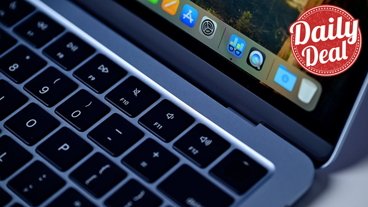


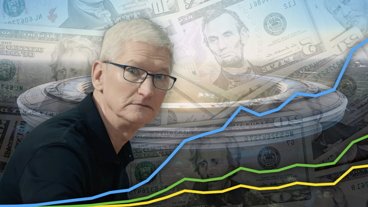



-m.jpg)





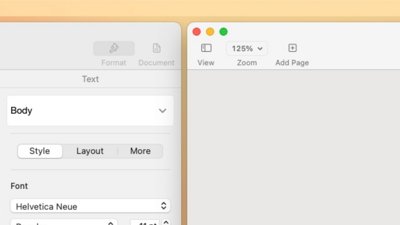
 William Gallagher
William Gallagher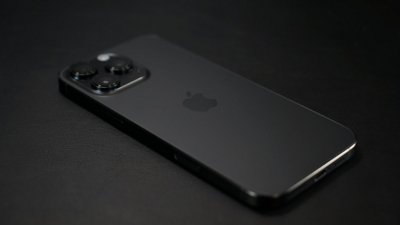
 Wesley Hilliard
Wesley Hilliard
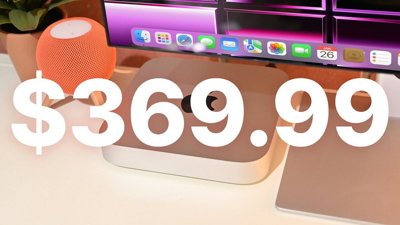
 Christine McKee
Christine McKee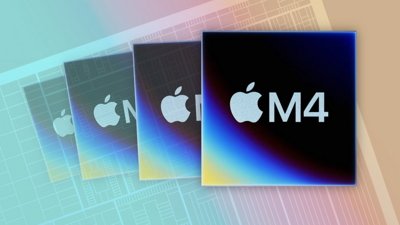
 Malcolm Owen
Malcolm Owen

 Andrew Orr
Andrew Orr



-m.jpg)




69 Comments
.........
How does 94 cents compare with Apple's year-ago guidance?
Ouch... AAPL down to 137 after hours... 11% drop, 16% for the day!
94 Cents is a 8% growth rate from last year. Consensus was $1.09, or a fairly conservative 25% growth.
Great quarter, but now everybody will be spooked about the overall economy killing them.
Crap. My stock's gettin' positively killed.
This sucks. Stevie, 3G iPhone, STAT!!! .
All sounds like excellent stuff.
Forgetting forecasts etc - Apple's revenues , profits, market share are all growing great.
As for forecasts, for the last few years Apple aims low, analysts aim medium, and performance exceeds both. So Apple forecasting lower than analysts for next quarter doesn't come as a surprise.
Am I missing anything?
(ps. Come on Apple, time to make the rest of the world a 1st class Apple citizen
[edit: sorry, not to make light of stock drops, but I figure that's part of the larger market, not Apple]